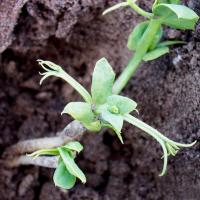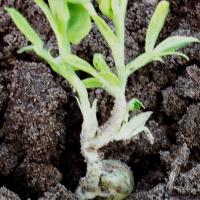Group D: Symptoms appear as the crop emerges. In most cases targeted weeds do not appear or are severely root pruned and do not survive.
Diagnosing group D herbicide damage in field peas
These are pre-emergent herbicides for the control of grasses and some broadleaf weeds in crops. Group D herbicide damage in field peas is rare.
What to look for
- Poor or intermittent emergence and stunting that often varies between drill rows or soil types.
- Damage is more likely on shallow sown plants in sandy soils with low organic matter.
Paddock
- Reduced, delayed or poor seedling emergence.
- Stunted seedlings with thickened hypocotyl, stem and tendrils.
- Multiple hypocotyl shoots.
- Leaves are small, thickened and blotchy yellow-green.
Plant
What else could it be
| Condition | Similarities | Differences |
|---|---|---|
| Diagnosing group B herbicide damage in field peas | Pale stunted seedlings with multiple hypocotyl shoots. | Germination is not affected, leaves have interveinal chlorosis, and damage will be worse on alkaline usually heavy textured soils. |
| Diagnosing virus damage in field peas | Pale stunted seedlings | Incidence is scattered and not related to soil type. |
| Diagnosing cutworm in canola and pulses | Any insect that severs the stem causes stunted seedlings with multiple hypocotyl shoots | Chewing damage evident |
Where did it come from?
- These herbicides can be lost to the atmosphere (particularly trifluralin) but are tightly bound to soil particles when incorporated into the soil. When these herbicides are used with no-till seeding, crop damage usually results from soil with herbicide being placed too close to the seed. Factors involved include
- Sowing too fast throwing herbicide treated soil into the adjacent furrows
- Variable depth of sowing
- Light-textured soils with low organic matter may be more affected.
- Mouldboard ploughing in sands buries topsoil organic matter that can lead to trifluralin toxicity at seeding depths that are normally safe.
See also
Further information
Page last updated: Wednesday, 13 May 2015 - 2:08pm




